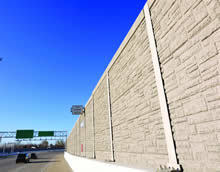
Driving around, you’ve probably noticed those tall sound barriers erected to minimize highway noise near residential areas and wondered if they work. Notre Dame’s Joe Fernando and those who live near Arizona’s East Loop 101 Freeway answer: “Not always.”
When the 101 Freeway was constructed several years ago near Scottsdale, engineers erected 8-foot-high “sound walls” to dampen traffic noise. Once the cars and trucks began flowing, so did the complaints. Strangely, Fernando says, most of the complaints came from residents about a half mile from the highway. In fact, the noise closer to the road was not as loud as that farther away.
Although standard calculations predict the barriers should have worked just fine, the Wayne and Diana Murdy Professor of Civil Engineering and Geological Sciences at Notre Dame suspected local atmospheric conditions shaped by the terrain might be distorting the sound waves, causing them to travel far enough to disturb the residents.
Fernando’s team and researchers from the Arizona Department of Transportation measured noise levels and atmospheric conditions near the roadway. Using the data, the Notre Dame engineering researcher developed mathematical models of highway sound transmission that take into account weather conditions.
Sure enough, the models showed that such things as wind shear and cooling temperatures at night could affect sound transmission. “Normally, sound goes in every direction,” Fernando says. “However, if wind is blowing toward a sound source, the sound going toward the wind will be lofted upward, while the sound moving away from the wind is concentrated down. Also, if the ground is hot, the sound will ride the hot air up, and then descend as the air cools, traveling in a big arc.”
While sound barrier walls can be effective in certain instances, Fernando says, “in this particular case there was no point because, as our mathematical model shows, the sound goes straight up. Our calculations showed the sound rising to 50 feet, so an 8- or 10-foot wall would have no effect.”
Fernando says the ND mathematical model offers highway designers a way to predict where sound barriers would be ineffective and not worth constructing, thus saving taxpayer money.
John Monczunski is an associate editor of Notre Dame Magazine.